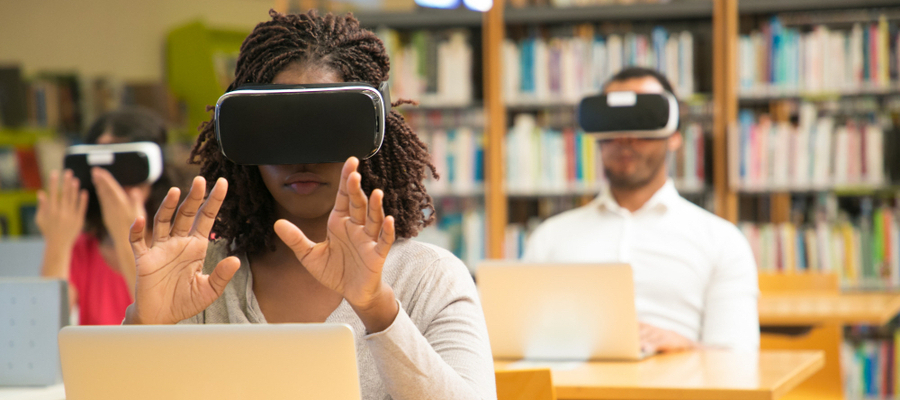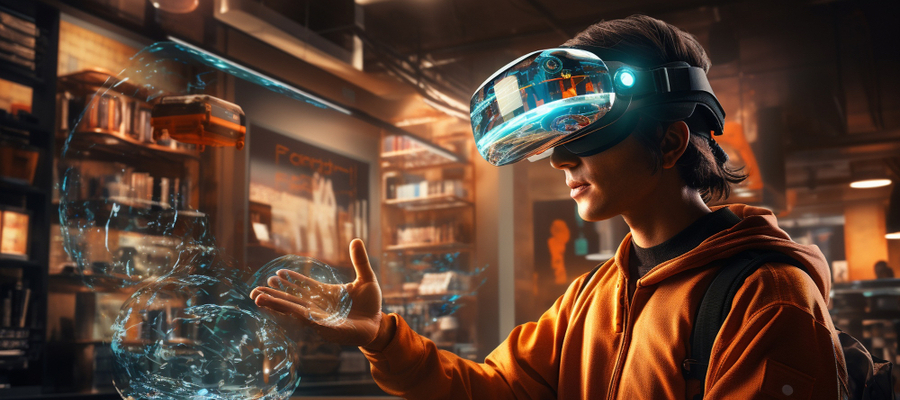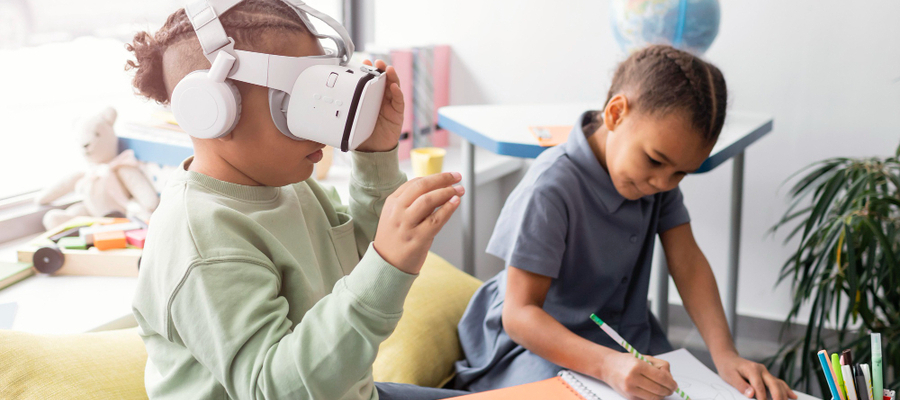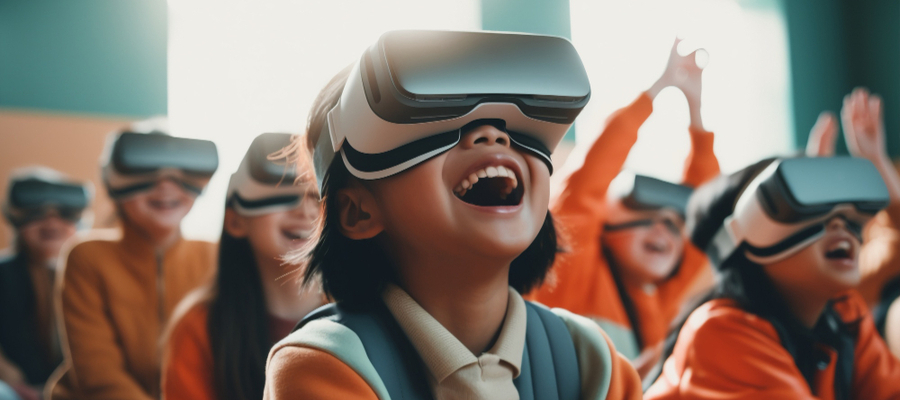As an educator deeply invested in the future of learning, I’ve witnessed firsthand the transformative potential of augmented reality in education. Augmented reality learning creates immersive experiences that engage students like never before, making complex concepts approachable and vibrant.
Augmented reality fosters a dynamic learning environment where curiosity thrives by bridging the gap between the classroom and the real world. In this exploration, I will share the latest trends, examine emerging tools, and share inspiring success stories that illustrate the profound impact of augmented reality on teaching methods and student outcomes.
This article builds upon my previous work on the statistics of emerging technologies.
What is Augmented Reality?

Definition and Examples
Augmented reality (AR) is a progressive technology that superimposes digital information onto our physical surroundings, enriching the learning experience. AR creates an interactive learning environment by facilitating hands-on learning and self-practice sessions, allowing students to engage more deeply with the material through virtual experiences. By integrating graphics, audio, and other sensory enhancements with the real world, AR transforms how students interact with educational content, making lessons more engaging and informative.
One prominent application of augmented reality in education is the use of interactive textbooks. These resources allow students to scan printed pages with their devices, revealing dynamic 3D models, videos, or animations corresponding to the studied material. Additionally, virtual labs allow students to conduct experiments and analyze complex scientific concepts in a safe and controlled setting, all from the comfort of their classrooms.
How AR Technology Works
Augmented reality technology operates by leveraging a blend of hardware, software, and sensors to accurately determine the position and orientation of objects in the surrounding environment. This intricate process enables the seamless integration of digital content with the real world, forming an immersive learning experience for students.
Devices commonly used for augmented reality, such as smartphones and tablets, are fitted with cameras and sensors to detect and track the user’s environment. This capability allows AR applications to overlay relevant information onto physical objects, enhancing the educational experience by providing immediate access to additional resources and interactive content.
Types of AR: Location-Based, Projection-Based, and Superimposition-Based
Location-based augmented reality (AR) uses the user’s geographical position to deliver contextual information about their surroundings. By utilizing GPS data, this AR type provides tailored content, like historical facts about landmarks or directions to nearby points of interest, enhancing the user’s engagement with their environment.
Projection-based augmented reality offers an interactive experience by projecting digital content onto physical objects in the user’s environment. This AR type transforms any space into a dynamic interface, letting users engage with the projected information as if it were part of the real world. Such applications are especially beneficial in educational settings, where complex diagrams or data visualizations can come to life through projection.
Superimposition-based augmented reality allows for modifying or replacing real-world images with digital elements, enhancing reality by overlaying new information onto physical objects. This provides users with a richer context. For instance, in medical education, students can better view a patient’s anatomy with digital data to understand complex structures and relationships within the human body.
Benefits of Using AR in Education
Enhanced Engagement and Motivation
Augmented reality (AR) fosters enhanced engagement and motivation by creating interactive and immersive learning experiences. This technology captivates students’ attention and encourages them to participate actively in the educational process, making learning more enjoyable and effective.
Furthermore, AR significantly contributes to student engagement by transforming traditional lessons into dynamic activities. By integrating digital elements with the real world, AR allows learners to explore content more hands-only, deepening their understanding and fostering a sense of curiosity about the subjects they study.
Improved Visualization and Understanding
Augmented reality (AR) presents complex concepts and abstract ideas in a visually engaging way, enhancing the learning experience. By creating a dynamic interface for students to interact with 3D models and simulations, AR makes challenging topics more accessible and understandable. This visual representation aids comprehension and sparks interest among learners.
Moreover, AR is essential for helping students visualize and understand complex concepts, like the systems within the human body. By overlaying digital information onto physical representations, learners can explore anatomy and functionality intuitively, making abstract ideas more tangible. This enhanced visualization promotes deeper understanding and encourages students to engage with the material more profoundly.
Differentiated Instruction and Accessibility
Augmented reality (AR) accommodates various learning styles, making it an invaluable educational tool. By catering to different modalities, AR enables teachers to develop personalized learning experiences that resonate with students. It appeals to auditory, visual, and kinesthetic learners, allowing each student to engage with content in a way that suits their unique habits.
AR accommodates various learning styles and ensures equal access to materials and opportunities for students with disabilities. By integrating assistive technologies and tailored digital content, AR enables all students to participate effectively in the learning process. This inclusivity empowers learners who face challenges in traditional educational settings, creating a more equitable experience for everyone.

Debunking Common Myths About AR in Education
Myth #1: AR is Only for Fun, Entertainment, and Gaming
Augmented reality (AR) is often seen as just a tool for fun and gaming, but its applications go much further. In educational settings, AR enhances learning by offering immersive and interactive occasions that engage students and spark their curiosity. When used effectively, AR boosts student engagement and encourages critical thinking, making it a valuable asset in modern education.
Moreover, AR offers many educational benefits. It promotes deeper learning strategies and allows students to explore complex concepts interactively. By harnessing AR, educators can create a more engaging learning environment that promotes collaboration, critical thinking, and real-world application of knowledge.
Myth #2: AR in Education is Expensive
While some may think augmented reality (AR) in education is expensive, it can actually be a cost-effective solution for many institutions. Schools can implement AR without a large financial investment using existing technology and platforms. Additionally, many AR applications offer flexible pricing models to fit various budgets, making it easier for institutions to adopt these innovative tools.
The long-term benefits of integrating AR can lead to lower training costs and a higher return on investment (ROI). By boosting student engagement and promoting effective learning, AR tools can enhance educational experiences and save costs over time. This positions AR as a strategic investment in the future of education, not just an expense.
Myth #3: Teachers Face a Massive Learning Curve
Contrary to the belief that teachers face a steep learning curve when integrating augmented reality (AR) into their methods, AR tools are designed for ease of use. Many applications feature user-friendly interfaces and support resources that help educators quickly understand how to implement AR in their classrooms. This accessibility allows teachers to incorporate AR into their lesson plans without significantly disrupting their teaching processes.
Integrating AR can significantly boost student engagement and develop critical thinking skills. By offering interactive and immersive experiences, AR encourages students to explore their subjects more deeply than traditional methods allow. This dynamic approach fosters an environment where learners can think critically, collaborate with peers, and apply their knowledge in real-world scenarios.
AR in Different Educational Settings
Primary and Secondary Education
Augmented reality (AR) has the potential to immensely enhance learning outcomes in primary and secondary education. By integrating AR into the curriculum, educators can create a more interactive and fascinating classroom environment that captivates students’ attention and fosters a deeper understanding of the material being taught.
In subjects like math and science, AR can facilitate the teaching of complex concepts by visualizing abstract ideas in a tangible way. This immersive approach enables students to grasp challenging topics more easily, allowing them to engage with the content in a stimulating and informative manner.
Higher Education
Augmented reality (AR) can greatly improve learning outcomes in higher education. By incorporating AR into college curricula, instructors can provide students with a more interactive and engaging experience. This technology allows for deeper exploration of complex subjects, enhancing understanding of intricate concepts.
AR can be highly beneficial in fields like medicine and engineering by teaching complex concepts through immersive experiences. For example, medical students can simulate surgeries or visualize anatomy in 3D, while engineering students can instantly manipulate virtual models to see their designs’ implications. This hands-on approach enhances comprehension and prepares students for real-world applications in their fields.
Vocational and Technical Training
Augmented reality (AR) can greatly improve vocational and technical training learning. By integrating AR into programs, educators can create an interactive environment that engages students and enhances their understanding of practical skills needed for their careers.
AR provides a dynamic way to teach complex concepts in welding and mechanics. With AR applications, learners can visualize processes and techniques, enabling them to practice skills in a safe, controlled environment. This immersive experience closes the gap between theory and hands-on application, ensuring students are well-prepared for their future careers.

AR Technology Trends
Mobile AR and Cross-Platform AR Applications
Mobile augmented reality (AR) is quickly gaining traction in education by allowing learners to access interactive content on their personal devices. This accessibility improves the learning experience, enabling students to engage with educational materials flexibly and conveniently. As mobile AR evolves, its potential to transform teaching and learning becomes increasingly clear.
Cross-platform AR applications create inclusive educational experiences that are accessible on various devices. Educators can reach a broader audience and cater to different learning styles by enabling users to engage with AR content across platforms. This flexibility enhances collaboration among students and maximizes the impact of AR technology in the classroom.
WebAR Solutions and AI Integration
WebAR solutions are transforming how users experience augmented reality by removing the need for downloads or installations. This easy access enables learners to engage with AR content directly in their web browsers, greatly enhancing the convenience and immediacy of educational interactions.
Integrating artificial intelligence (AI) with augmented reality can personalize learning and deliver real-time feedback to students. This combination customizes educational content to meet individual needs and offers instant support, helping learners grasp concepts more effectively.
Emerging Trends and Technologies
Emerging trends and technologies, such as AR cloud and light field displays, are set to significantly enhance augmented reality experiences in education. These advancements aim to create immersive and interactive learning environments, enabling richer content delivery and a deeper understanding of complex concepts. As these technologies evolve, they could revolutionize educational practices and engage students more effectively in their learning journey.
AR Apps in Education
STEM Education and AR Apps
AR apps play a pivotal role in teaching complex STEM concepts, such as physics and chemistry, by providing interactive and engrossing experiences for students. Through the use of an AR app, learners can visualize and manipulate intricate ideas, making challenging subjects more accessible and understandable.
Moreover, AR apps offer real-life examples and simulations that bring STEM concepts to life. By allowing students to interact with realistic scenarios, these applications help bridge the gap between theoretical knowledge and practical application, fostering a deeper understanding of scientific principles.
History and Art Education with AR
AR can be used to teach history and art interactively. By incorporating augmented reality into lessons, educators can create immersive experiences that bring historical events and artistic movements to life, capturing students’ interest and fostering a deeper appreciation for these subjects.
Additionally, AR technology allows for virtual tours and interactive exhibits of historical sites and art museums. Students can explore these venues from anywhere, accessing a wealth of information and visuals about important cultural landmarks and masterpieces, enhancing their understanding and engagement with history and art.
Medical and Healthcare Education using AR
AR can effectively teach medical and healthcare concepts, including anatomy and surgical procedures, by providing an interactive and engaging learning environment. Students can visualize complex structures and processes through augmented reality, enhancing their grasp of intricate medical knowledge. Such immersive experiences allow learners to explore anatomical details and understand procedural steps in a way that traditional methods may not achieve.
Additionally, AR can provide real-life examples and simulations of medical and healthcare procedures, allowing students to practice critical skills in a safe, controlled setting. This hands-on approach boosts confidence and improves knowledge retention, preparing students for real-world challenges they may encounter in their medical careers.

Success Stories and Case Studies
AR in K-12 Education: A Success Story
Augmented reality can greatly improve learning outcomes in K-12 education. By integrating AR into the curriculum, educators provide students with a more interactive experience, making lessons engaging and relatable. This technology helps visualize complex concepts, enabling students to understand challenging subjects like mathematics and science better.
Additionally, AR can teach various subjects in an engaging way. For example, students can explore scientific principles or mathematical theories in real time through dynamic simulations, creating a more immersive learning environment. This approach captivates students’ attention and encourages active participation, leading to better understanding and knowledge retention.
AR in Corporate Training: Best Practices
Augmented reality can significantly enhance learning outcomes in corporate training. By incorporating AR technology, organizations can provide employees with a more interactive learning experience, improving understanding and skill acquisition.
In addition to boosting engagement, AR is effective in teaching complex concepts like leadership and communication. Employees can practice and develop these essential skills in a realistic, supportive environment through immersive simulations and real-time interactions. This hands-on approach fosters deeper understanding and encourages practical application, benefiting both individuals and organizations.
Implementing AR in Education
Identifying Learning Objectives and Content
AR content should be thoughtfully crafted to align with specific learning objectives and outcomes. This ensures that the use of augmented reality enhances the educational experience and meets clear educational goals.
Moreover, AR content must be designed with these objectives in mind. By doing so, educators can create relevant and meaningful experiences that engage learners and facilitate a comprehensive understanding of the material being presented.
Ensuring Adequate Resources and Support
AR needs proper resources and support to be effective in corporate training. This includes suitable hardware, software, and access to training materials that help employees use the technology. Without these resources, the potential of augmented reality to enhance learning can be significantly reduced.
Additionally, a dedicated AR platform is vital for successfully implementing augmented reality in education. This platform should enable seamless integrations and provide user-friendly experiences. Technical support is also crucial to resolve any issues, ensuring learners have uninterrupted access to the resources they need to succeed.
Providing Training and Support for Educators
Educators need proper training and support to use AR technology effectively in teaching. This training should cover boththe technical skills to operate AR tools and strategies for integrating them into existing curricula. Well-prepared educators can use augmented reality to enhance student engagement and improve learning outcomes.
Moreover, educators must be trained to incorporate AR into their curriculum seamlessly. Understanding how AR can support and enhance learning objectives empowers educators to create richer, more interactive educational experiences. This knowledge ensures that AR technology is an add-on and a meaningful component of their teaching toolkit.

Overcoming Challenges and Limitations
Cost and Resource Constraints
Augmented reality can be expensive for some educational institutions. The costs of acquiring the necessary technology and software can be a significant obstacle, especially for budget-constrained schools. This financial challenge can limit the accessibility and use of AR in classrooms.
Additionally, augmented reality needs substantial resources and support to be effective. Schools must invest in technology, infrastructure, training, and ongoing technical support. Without sufficient resources, the potential benefits of AR in education may go untapped, limiting its impact on teaching and learning.
Technical Challenges and Device Management
Augmented reality demands a level of technical expertise for effective setup and maintenance. Educators and IT staff need to understand AR technology to troubleshoot issues and ensure smooth integration into the classroom. This knowledge is vital for maximizing the educational benefits of AR tools.
Device management is a crucial aspect of using augmented reality in education. Proper setup, maintenance, and updates are vital for effective use. This includes managing software installations, maintaining device functionality, and guiding users on operating the technology. Without proper device management, the potential of AR to enhance learning experiences can be greatly diminished.
Lack of Content and App Store Limitations
The availability of augmented reality content is often limited, making it difficult for educators to find resources that align with their curriculum. This scarcity can hinder the effective integration of AR into lessons, as teachers may struggle to identify suitable applications that enhance student learning.
Restrictions imposed by app stores can complicate access to AR applications, limiting the tools available to educators and stifling innovation in classroom use. Consequently, teachers may feel constrained in exploring and implementing AR technology in their teaching practices.
Developing AR Training Applications
Key Considerations and Best Practices
AR training applications should be specifically designed to support targeted learning objectives. Educators can ensure students clearly understand the material by aligning features and content with desired educational outcomes. This focused approach allows for a more structured and effective use of augmented reality in education.
AR training applications should align with learning objectives and deliver interactive and engaging experiences. These applications can create a more immersive educational environment by including elements that spark student interest and encourage active participation. Engaged students are more likely to retain information and apply their knowledge practically, making interactivity a crucial aspect of AR training tool design.
Tools and Resources for Development
Developing AR training applications requires careful consideration of various factors to ensure effectiveness. One key aspect is aligning the applications with specific learning objectives. By designing AR experiences that directly support educational outcomes, educators can help students grasp the material more effectively. This focused approach leads to a more structured and impactful integration of augmented reality in education.
A key factor in developing AR training applications is creating interactive and engaging learning experiences. Incorporating elements that capture student interest and encourage active participation is essential for fostering an immersive educational environment. When students are engaged, they are more likely to keep information and apply their knowledge in real-world situations. Thus, interactivity is crucial in designing AR training tools that enhance the learning experience.

Concluding Remarks
The Future of AR in Education: Opportunities and Challenges
AR has the potential to change education by providing interactive and engaging learning experiences that capture students’ attention and deepen their connection with the material. This technology incorporates gamified elements and real-time feedback, making learning both informative and enjoyable.
Moreover, AR tackles major educational challenges, like cost and resource limitations. By offering equal access to learning materials and opportunities, AR can democratize education, ensuring that all students, regardless of background, have the tools they need to succeed in a rapidly changing academic landscape.
Final Thoughts and Recommendations
AR should be considered a valuable tool for enhancing learning outcomes in education. By leveraging its interactive features, educators can create an environment that keeps students engaged and significantly improves their understanding of complex subjects.
Furthermore, integrating AR into the curriculum is essential to provide interactive and captivating learning experiences. Incorporating this technology into lessons fosters an innovative approach to education, encouraging students to participate in their learning journey and actively explore concepts.
Explore my other articles to discover more insights and practical applications of AR in education—let’s redefine the learning experience together!
Frequently Asked Questions about Augmented Reality in Education
1. What is Augmented Reality?
Augmented Reality (AR) is a technology that covers digital content, such as videos, images, and 3D models, in a real-world environment. This can be done through different devices such as smartphones, tablets, and AR headsets.
2. How does AR benefit education?
AR in education allows for more interactive and engaging learning experiences. It also has the potential to make complex concepts easier to understand through visualizations and simulations. Additionally, AR can provide equal access to learning materials and opportunities regardless of location or resources.
3. Is AR expensive for educational institutions?
With technological advancements, AR tools have become more affordable for schools. Many free AR apps and software are also available for educational use.
4. Are there any challenges with integrating AR in education?
Some challenges include the initial cost of implementing AR, technical support and maintenance, and ensuring equal access to devices and resources. Teachers and students may also experience a learning curve when using AR technology effectively.
5. How can I incorporate AR into my classroom or lessons?
There are many ways to incorporate AR into education, such as using it for virtual field trips, interactive worksheets, or creating 3D models for science experiments. It is important to research and plan ahead to ensure that the use of AR aligns with your learning objectives and curriculum goals. You can also collaborate with other teachers or utilize online resources for lesson ideas and support.
6. What are the potential future developments of Augmented Reality in education?
We can expect to see more immersive and personalized learning experiences as AR technology advances. This may include more advanced simulations and virtual labs, as well as AI integration for adaptive learning. With the expanding popularity of hybrid and remote learning, AR could also play a significant role in closing the distance between virtual and physical classrooms.



